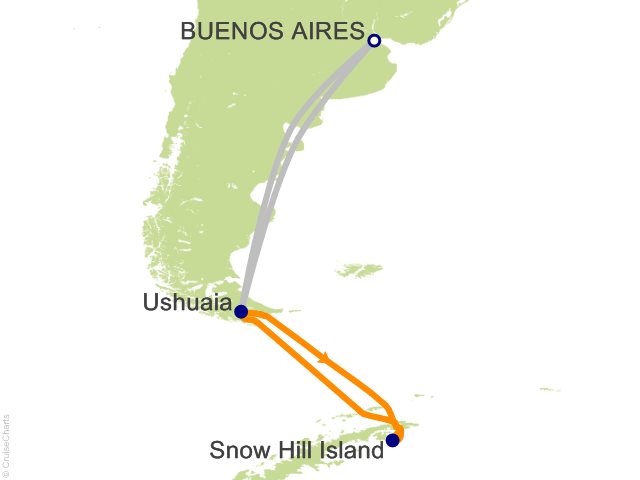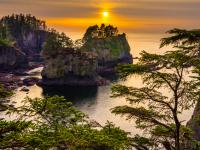The journey toward Snow Hill Island will put you in explorer mode as the captain and expedition leader keep you updated through weather briefings, meteorological and sea ice condition reports. The thickness of ice will determine how close Ultramarine can get to Snow Hill Island, then our twin-engine helicopters will take over. Like summitting a mountain from base camp, parties will set out from Ultramarine towards the emperor penguin colony. Their adventure begins with an extended helicopter transfer that will reveal a landscape of snow-capped peaks and apartment-building-sized tabular icebergs. The rookery itself is located on the sea ice off the south coast of Snow Hill Island and the landing will be as close to the penguins as possible, yet at a safe distance to avoid disturbing the birds. Upon landing, your party will walk across the ice to the fabled emperor penguin colony. The wind. The ice beneath your feet. Walking next to paths in the snow carved by penguins that came before. And then there are the incredible sounds of the penguins in the distance as you march toward one of the rarest wildlife opportunities on the planet: the colony of thousands and thousands of rarely-seen emperor penguins. The goal of the expedition is to get every guest to the remote rookery once. The Expedition Team and special experts will be close by to answer your questions and ensure you take in everything there is to see. You'll observe close up how the emperor penguins behave as a tight-knit community, how they care for their young, and how they body surf across the ice in a way that can only be described as quirky yet efficient. The helicopter expedition in search of the emperor colony might just be the adventure of a lifetime And while at base on Ultramarine with your attentive Expedition Team, you'll be immersed each day in the polar experience of the Weddell Sea. Daily activities will include Zodiac cruising among the icebergs, adventuring and learning while atop the ice, paddle-on-top kayaking, or working with onboard team to observe the weather forecasting and ship operations up close. A particularly enriching component of your voyage will be the bespoke educational programs tailored specifically for this expedition that offer both traditional (lecture format) and hands-on opportunities for learning about this fascinating region. Each day the polar experts, who include penguin scientists, biologists, and polar historians, will present on various aspects of emperor penguins and their behaviors, ice formations such as the tabular icebergs which you'll see from the deck of your ship, and the experiences of polar explorers who braved the Weddell Sea over a century ago. Or you might, on one of these days, decide to take the polar plunge, or test your balance on a stand-up paddleboard. Then again, maybe you'll enjoy a little pampering. If so, you can choose from Ultramarine's excellent onboard amenities, including the spa, sauna, and fitness room. The emperor penguin colony at Snow Hill is the goal of this expedition. However, if weather or ice conditions prevent us from visiting the colony or shorten the duration of our visit, we may explore some of these other sites. Your possible landings in Antarctica will take place on the eastern side of the Peninsula, which is an extension of the Transantarctic Mountains and is the most northern stretch of Antarctic land. Brown Bluff: An immense cliff of volcanic rock, towers 2,225 feet (678 meters) over rookeries of Adelie and gentoo penguins, some of which will be incubating their eggs. Devil Island: The Swedish Antarctic Expedition of 1901-04 discovered the narrow island, which is 1 mile (1.6 kilometers) long and has a low summit at each end. Hope Bay: Three members of the Swedish Antarctic Expedition (1901-04) spent the winter in a hut on the shores of Hope Bay. The hut is located close to the jetty of Esperanza Station, an Argentine research station. Paulet Island: Located in the northwestern Weddell Sea, Paulet Island is home to a large Adelie penguin rookery. With a volcanic cone that rises 1,158 feet (353 meters), the island reminds you that this was once a very active landscape. In addition to penguins, you may be interested in visiting a historic hut built by members of the Swedish Antarctic Expedition of 1901-04. A cross marks the gravesite of crew member Ole Wennersgaard. Seymour Island: Northeast of Snow Hill Island is a smaller island that was originally mistaken for a cape. Seymour Island is significant for fossil finds and for the remains of the K-T Boundary, which marks the transition between the Cretaceous Period (dinosaurs and reptiles) and the Tertiary Period (mammals) of geological times. This era is known for the mass extinction of many forms of life, including dinosaurs. ...
Read More




 Track this Cruise.
Track this Cruise.  Favorite this Cruise and receive Price Alerts when the rates go up or down.
Favorite this Cruise and receive Price Alerts when the rates go up or down.














